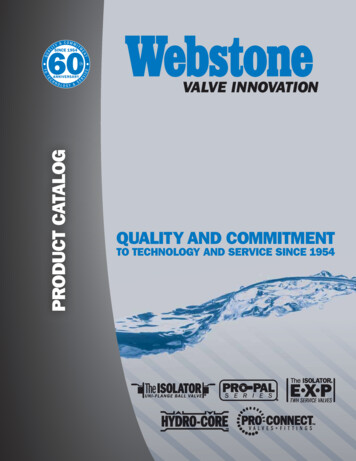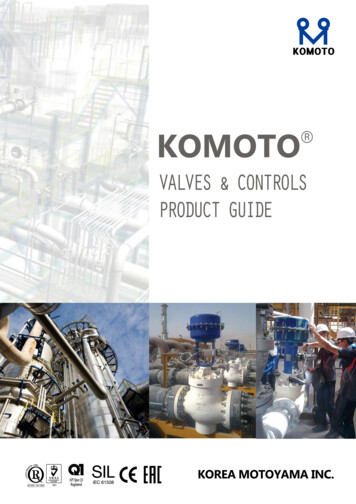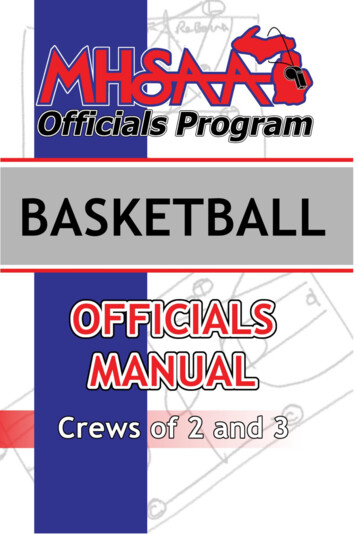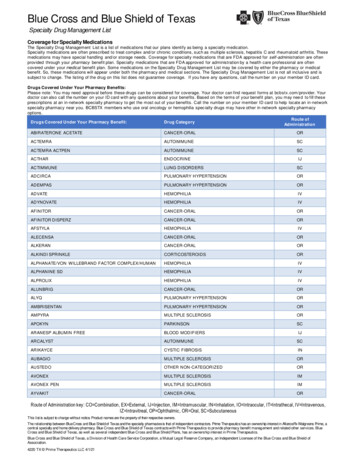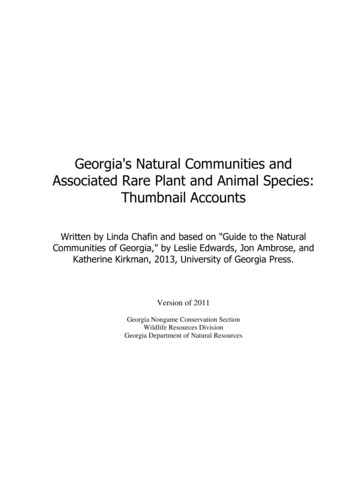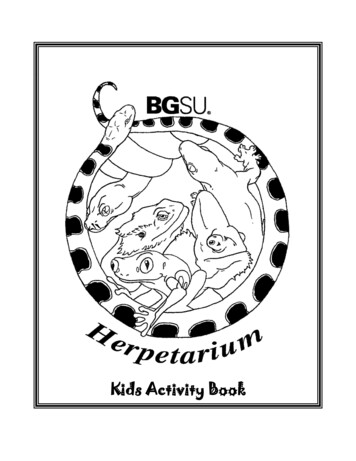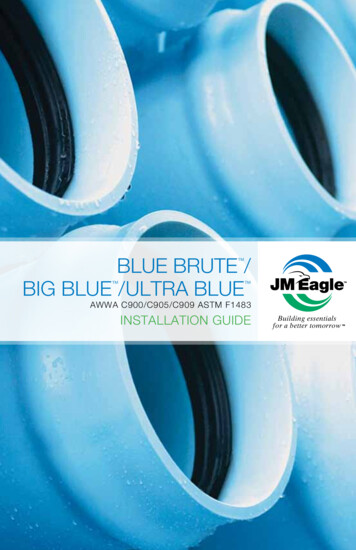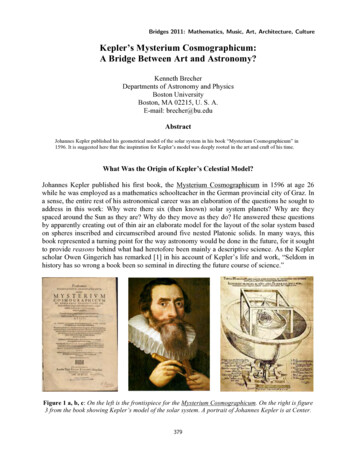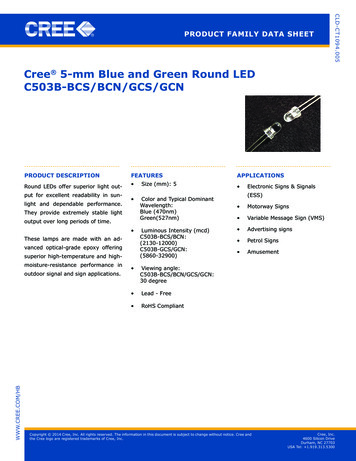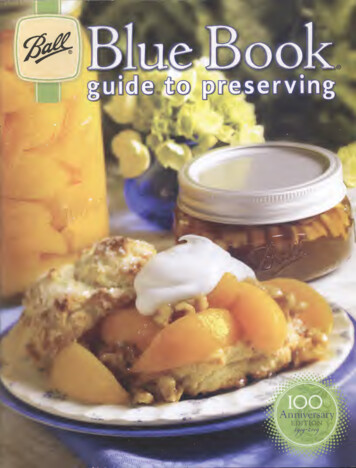
Transcription
AnniversaryEDITION
Ball Blue Book Guide To PreservingCe/e/rct uid()100 Pearsfres/i fhOne hundred years ago, the Ball Corporation published the premier issueof the Ball Blue Book* Guide to Preserving. Since then, the joy of preservingfoods at home has been celebrated in each edition, with tried and truerecipes that capture the natural flavor of the harvest season and bring itBright to your table.is a fact of life a century ago. Today, it's an artful craftit brings wholesome, nutritious fruits and vegetables to every dish, inany season. Times have changed; our busy lifestyles demand fresh solutions. And the Ball BlueBook Guide to Preserving delivers, with innovative recipes that transform garden favorites intocontemporary classics.For generations, cooks have relied on this book for answers to their questions about safe foodpreservation. The Ball Blue Book Guide to Preserving has evolved through the years to reflectchanging needs, tastes and trends. Over the decades, this popular book has introduced dozensof proven recipes that stand the test of time. Some of the most notable changes occurred withthe advent of home freezing (1949), the inclusion of low-sugar and low-salt options (1982),consumer interest in gourmet recipes (1984), as well as interest in the oldest method of foodpreservation—dehydrating (1984). However, one thing remains the same—the trusted placethis guide has earned in the kitchens of cooks the world over.Jarden Home Brands is pleased to present this celebratory edition of the Ball Blue Book Guideto Preserving. As the leader in home food preservation, we are dedicated to continuing thetradition begun by the Ball brothers more than 100 yearsago. From generation to generation, families have enjoyedthe treasures of home preserving. We hope the recipes inthis book help you capture that same joy.
contentsLea rn i ng About Ca n n i ngjust one step beyond cooking 2Home Canning Principles 3EquipmentsAltitude Adjustments 5HeadspacellProcessing 12Storage 12High-Acid Foodsfruits, juices & tomatoes 14Fruits 17Peaches preserved at their seasonal peak servedshortcake is like a taste of summer any time o:for this easy-to-make dessert is cFruit Juices, Nectars & Purees 21Tomatoes 22Canning Tomatoes Step-By-Step 24Soft Spreadsjams, jellies 8C fruit spreads 26Gelling Test 29Jams 32Juice For Jelly 30Jellies 35Butters 30Marmalades 37Conserves 31Preserves 39Canning Jams Step-By-Step 42Pickled Foodschutneys, pickles 8 C relishes 44Brined Pickles 47Fruit Pickles 52Fresh Pack Pickles 49Relishes 53Chutneys 51Sauces 54Other Pickled Foods 55Low-Acid Foodsmeats, seafoods Sc vegetables 58Meats 60Seafoods 61Tomatoes 69Entrees, Soups & Stocks 62Vegetables 66Canning Green Beans Step-By-Step 70Special Dietlow-sugar Sc low-salt recipes 72Fruits& Tomatoes 74Soft Spreads 75Pickled Foods 76Meats & Vegetables 77Something Extrasweet & savory condiments, gourmet spreads 8C salsas 78Sweet Spreads 80Hot&Savory81Flavorful Sampler 85Infusions & Condiments 82Pickled & Spicy 85Freezingspreads, meats, vegetables SC prepared foods 88Dairy Products 93Poultry 98Fruits & Fruit Fillings 93Prepared Foods 98Vegetables 101Freezer Spreads 96Seafoods 100Meats 97Special Diet & Baby Foods 101Freezing Corn Step-By-Step 105Dehydratingfruit leathers, jerky & rubs 106Fruits 109Fruit Leathers 110Beef Jerky 111Cooking With Dehydrated Foods 113RubslllVegetables 112Dehydrating Apples Step-By-Step 115Planning Guidefrom narvest to preserving 116Home Canning Planning Guide 116Weight & Measure Equivalents 117The Problem Solveranswers to common food preservation questions 118Glossaryfood preservation terms 123Indexrecipes, food types, main ingredients 125Home Canners' Help Line: 1-800-240-3340 FreshPreserving.com
just one step beyond cookingRow after row of empty Ball* pint, quart and jelly jars stand at the ready. What will you fillthem with? The possibilities are endless. When gardens overflow with the harvest, it's time tocapture the abundance of the summer season.Whether you are a first-timer or you have been canning for decades, you want to giveyour family the tastiest, healthiest, most nutritious foods possible. In the pages of this book,you will find everything you need to know about canning and preserving, as well as a host ofsweet and savory recipes that will bring natures goodness to your table—right through thewinter months.This section of the book contains detailed information about food classification, canningequipment, and methods for preserving—everything from pre-canning planning basics topost-processing storage. No one offers an easier-to-follow, more complete reference than theBall Blue Book Guide to Preserving. Well walk you through every step, complete with testedrecipes and time-saving tips.The irresistible appeal of canning and preserving is timeless. Let the whole family join inthe fun of harvesting, preparing, simmering and preserving homemade goodness. Seal thefreshness of the season in Ball jars; you will be amazed at the sense of accomplishment you feelwhen you place your trophies on the pantry shelf.The Ball Blue Book Guide To Preserving has been the unrivaled guide to home canning for100 years. As we celebrate this milestone edition, we hope the recipes will inspire you tocreate flavorful, healthy dishes that come from the best place of all—your kitchen.2Ball Blue Book guide to preserving
IIIIIIIIIIIIIIIIIIIII L !!Ilearning about canningHome Canning PrinciplesUnderstanding how to prevent food spoilage and deterioration is the keyto canning safety and success. In the air and all around us are invisiblemicroorganisms, such as molds, yeasts and bacteria. Many of thesemicroorganisms are beneficial to us, while others can be harmful undercertain conditions. These “spoilers" live and multiply on the surface offruits, vegetables, meats and all other types of food. Foods affected bybruising, insect damage and disease are more likely to have greater levelsof microorganisms associated with spoilage. Enzymes change the color,texture and flavor of food and are found throughout the tissue of eachfood type. If enzyme activity goes unchecked, food quality will deteriorate.Molds, yeasts, bacteria and enzymes are the major causes of foodspoilage and loss of quality.Controlling the conditions which encourage the growth of molds,yeasts, bacteria and enzymes is an important factor in controllingspoilage and decaying. Washing foods is helpful in removing some of thespoilage microorganisms. Peeling and blanching reduces even greaternumbers of spoilage microorganisms. Blanching is also a good way tominimize the effects of enzyme activity.Canning interrupts the normal spoilage and decaying cycle of foodby heating the food contained in a home canning jar that has been closedwith a two-piece vacuum sealing cap. When heat is applied at the correcttemperature and held there for the time designated by a specific testedhome canning recipe, it destroys potentially harmful microorganisms; atthe same time, it drives air from the jar. Upon cooling, the lid seals ontothe jar. The vacuum that has formed prevents other microorganismsfrom entering and contaminating the food. This procedure is alsoknown as processing. Correct processing methods and times adequatelydestroy normal levels of heat-resistant microorganisms. Proper storageand handling of sealed jars also helps ensure that home canned foodswill be free of spoilage.Ensuring Quality FoodsControlling microorganisms, enzymes, oxygen and moisture loss in foodhelps ensure a quality canned product. To achieve a top-quality finishedproduct, start with top-quality fresh produce. Select produce at its peakof freshness and flavor, and choose varieties best suited for canning.Remember, preserving food does not improve its quality. It is best to canfruits and vegetables immediately after harvesting or purchasing. Anyfoods you are unable to can within a couple hours must be properlystored to minimize further deterioration. When you are ready to can,carefully remove small diseased areas or bruised spots. Discard heavilydiseased, moldy, insect-damaged and overripe food. Microorganismsmultiply rapidly on damaged or diseased areas and may be at such highlevels that the processing times, developed for quality foods, will notdestroy all the microorganisms present in lesser-quality foods.It is helpful to understand how acid and temperature affect molds,yeasts, bacteria and enzymes.Molds And YeastsMolds are fungi that grow as silken threads and appear as fuzz on food.Some molds can produce mycotoxins which are harmful to eat. Moldsthrive on the acids that are a protection against bacteria. Yeasts, whichare also fungi, cause food to ferment, making it unfit to eat. Fortunately,the acid in foods protects against the growth of bacteria; however, moldsand yeasts are ever-present. Molds and yeasts are easily destroyed attemperatures between 140 and 190 F. Boiling-water processing heatsfoods to 212 F, more than enough to destroy the molds and yeastswithout destroying the quality of the product (see figure 1).BacteriaBacteria are not easily destroyed. Certain bacteria actually thrive attemperatures that destroy molds and yeasts. Salmonella is destroyedwhen held at 140 F. Staphylococcus aureus, or "staph," is destroyed iffood is kept above 140 F. Staph bacteria produce a toxin that must bedestroyed by heating the product to 240 F for the time specified by atested home canning recipe (see figure 1).Botulism is a food poisoning caused by the bacterium Clostridiumbotulinum. This bacteria is also readily destroyed by boiling; however,the toxin producing spores cannot readily be destroyed at 212 F.Furthermore, the botulism-causing bacteria thrives on low acids in theabsence of air in moist environments—exactly the conditions inside ajar of canned vegetables, meats and other low-acid foods.
Because of bacterial spores and the toxins they produce, low-acidfoods must be processed at 240 F, which is hotter than the boiling pointof water. This can be accomplished only with a steam-pressure canner.EnzymesEnzymes are present in all living things. They promote the normalorganic changes necessary to the life cycle. Their action can cause food tochange flavor, texture and color, making it unappetizing. Enzymes, likemolds and yeasts, are easily inactivated by heat at temperatures beginningat 140 F. Enzymes are inactivated by the boiling-water process.Classification Of FoodsThe importance of the pH, or acidity of foods, is that it determines themethod of heat processing necessary for a safe canned product. Figure 2lists common foods and gives their relative acidity.For the purpose of canning, all foods are divided into twoclassifications determined by the amount of natural acid present in thefood or the acidification of the food to a specific pH level. The twoclassifications are:High-Acid Foods And Acidified FoodsThese foods have naturally high levels of acid or have a sufficientamount of acid added to them. Bottled lemon juice, citric acid or vinegarlabeled 5 percent acidity are sometimes added to recipes to increaseacidity. Foods in this category must have a pH of 4.6 or less. The boilingwater method of processing is adequate for high-acid foods. Generally,all fruits and soft spreads are classified as high-acid foods. Figs andtomatoes require the addition of an acid so they may be safely cannedusing the boiling-water method. Fermented foods, such as sauerkrautand brined pickles, and foods to which a sufficient amount of vinegar isadded are also treated as high-acid foods. Some recipes may call forhigh-acid and low-acid ingredients but still be classified as a high-acidproduct; these recipes must have a pH level of 4.6 or less.Low-Acid FoodsThese foods have very litde natural acid. Vegetables, meats, poultry andseafoods are in the low-acid group. Soups, stews, meat sauces and otherrecipes which contain a combination of high-acid and low-acid ingredients,yet remain with a pH level greater than 4.6, must be processed as alow-acid product.figure 2 I Relative Position Of Various Foods On pH (Acidity-Alkalinity) ScaleApproximategrowth limits for:MoldsYeastsHigh-Acid FoodsLemonsPicklesGooseberriesApricotsApples, BlackberriSour CherriesSauerkrautPearsTomatoes.Process at 212 F inBoiling-Water CannerOkraCarrotsBeets, TurnipsGreen Beans, SpinachAsparagusLow-Acid Foods14 Strong AlkaliProper Processing MethodsInstructions in this book apply only to two proven processing meth ods—boiling-water canning and steam-pressure canning. As discussedearlier, the processing method required for foods is determined by thepH of the specific food being canned. The processing method and pro cessing time given for each recipe in this book must be followed exactlyas stated. Processing methods and times are not interchangeable.Periodically, old methods of preserving food are revived. Thesemethods are not reliable and not recommended. Conversely, theadvancements in technology bring new methods and equipment to theforefront. Unless proven to be safe and reliable by appropriate authorities,they must be avoided.The tested processing times in this book are only for use with boilingwater processing and steam-pressure processing. These times have notbeen tested for use with any other methods or recipes for home canning.Boiling-Water MethodHigh-acid foods are processed in a boiling-water canner. The heat istransferred to the product by the boiling water which completelysurrounds the jar and two-piece cap. A temperature of 212 F is reachedand must be maintained for the time specified by the recipe. Thismethod is adequate to destroy molds, yeasts and some bacteria, as wellas to inactivate enzymes.A boiling-water canner must not be used for processing low-acidfoods. The boiling-water method never reaches the high temperaturesneeded to destroy certain bacterial spores and their toxins, which canproduce botulism.All of the boiling-water processing times given for the high-acidrecipes in this book are for processing at or below 1,000 feet above sealevel. If you are located at an elevation greater than 1,000 feet, you mustincrease the processing time to compensate for the lower boiling point ofwater (seefigure 3).Steam-Pressure MethodLow-acid foods must be processed in a steam-pressure canner. In orderto destroy all bacteria, their spores and the toxins they produce, low-acidfoods must be heated to a temperature of 240 F and held there for the
Ihome canning principlestime specified bp the recipe. Because the steam inside the canner ispressurized, its temperature exceeds the boiling point of water. At 10pounds pressure, using a weighted-gauge canner, the temperature willreach 240 F (at or below 1,000 feet above sea level), which is hot enoughto destrop the bacterial spores that emit toxins.The pounds of pressure given for low-acid recipes in this book arebased on the use of a weighted-gauge canner and for processing at orbelow 1,000 feet above sea level, for the time indicated bp the recipe. Ifpou are located at an elevation greater than 1,000 feet above sea level,pou must increase the processing temperature bp adjusting the poundsof pressure used; the processing time remains the same. Adjustments forusing a dial-gauge canner or processing at higher altitude areas are listedin the Altitude Chart (see figure 3).Altitude AdjustmentsBarometric pressure is reduced at high altitudes, affecting the temperatureat which water boils. This means boiling-water and steam-pressure canningmethods must be adjusted to ensure safe processing. When using theboiling-water method, additional processing time must be allowed.With the steam-pressure method, additional pounds pressure isrequired. The Altitude Chart gives the requirements for both methodsat various altitudes (see figure 3).figure 3 Altitude ChartBoiling-Water MethodThe processing times given in this book for high-ac:vel using the boiling-water method. Whenat altitudes higher than 1,000 feet above sea: the processing time according to this Boiling-Water CanneBoiling-Water Canner Altitude AdjustmentsAltitude In FeetIncrease Processing Time1,001 to 3,0005 Minutes3,001 to 6,00010 Minutes6,001 to 8,00015 Minutes8,001 to 10,00020 MinutesSteam-Pressure MethodThe steam-pressure method is used for low-acid foods.The pounds pressure given for low-acid foods in thisbook are based on using a weighted-gauge canner andprocessing at or below 1,000 feet above sea level. Whenusing a dial-gauge canner or processing at altitudes higheLthan 1,000 feet above sea level, adjust pounds pressure accordingto this Steam-Pressure Canner chart.Steam-Pressure Canner Altitude AdjustmentsGeneral cooking and baking times and temperatures are based onaltitudes at or below 1,000 feet above sea level. Follow standard cookingand baking guidelines for pour elevation.If pou do not know the altitude for pour location, contact pourcountp Cooperative Extension Service. Alternative sources of informationare pour local Soil Conservation Service and pour Public Librarp Service.EquipmentImprovements in canning equipment, kitchen utensils and small appliancesmake canning a simple, safe and efficient method of food preservation.Most equipment used for home canning is readilp available in a wellequipped kitchen, A little pre-planning to check that all equipment andingredients are on hand in advance of the intended dap of canning willallow pou time to acquire anp items pou map need (see page 8).JarsGlass home canning jars, sometimes called Mason jars, are the onlp glassjars recommended for home canning. Thep come in a wide varietp of sizesand stples (see page 8). These jars are carefullp made to fit homecanning lids, ensuring a good seal is achieved when tested recipes andprocessing methods are followed correcdy. The glass in the jars ismanufactured to withstand the heat of the steam-pressure canner or thesub-zero temperature of the freezer. However, standard home canningjars, those with rounded shoulders, are not suitable for freezing and mustonlp be used for canning. Jars designed for canning and freezing havetapered sides without the rounded shoulders.Other features designed into home canning jars map include fruitembossed or quilted glass patterns, space for labels, regular or widemouth openings, and sizes ranging from four ounces to one-half gallon.Use onlp the jar size indicated bp a specific, tested home canningrecipe and follow the processing method and time exactlp as stated.Older stple canning jars once suitable for home canning should nolonger be used for this purpose. Manp of these jars cannot be properlpfitted with two-piece vacuum caps, and new closures of original designare not available. Commercial jars like coffee, spaghetti sauce, fruit andbabp food jars are designed for a single commercial application; therefore,thep are not recommended for home canning. Commercial jars map notwithstand the temperatures required for home canning. In addition,commercial jars varp in size which map prevent the lid from sealing andpossiblp leave the food underprocessed.Note: The processing methods and times given in this book applponlp to home canning jars marketed bp Jarden Home Brands.Lids And BandsHome canning two-piece vacuum caps (lid and band) come in regular andwide-mouth sizes (see page 8). The set consists of a flat metal lid with aflanged edge, the underside of which is filled with a sealing compound, anda threaded metal screw band that fits over the rim of the jar to hold the lidin place during processing. Lids are not reusable; however bands can bereused if thep are in good condition.Incidence of seal failure is verp high when older stple closures andcommercial caps are used. Zinc caps and glass lids that seal with ajar rubbershould not be used for canning. These closures are not recommendedsince there is no wap to determine if the closure is sealed. Commercialcaps are onlp intended for one-time commercial application, makingthem inadequate to use for home canning.Learning About Canning
Boiling-Water CannerFoods naturally high in acid and acidified foods having a pH of 4.6 orless may be processed in a boiling-water canner (see figure 4). The boilingwater method is essential for safely canning fruits, soft-spreads,tomatoes, pickles and other acidified foods. Filled jars sealed withtwo-piece caps are submerged in water to cover by 1 to 2 inches. Waterin the canner must maintain a boil, 212 F, during the entire processingtime as specified by a recipe tested for canning. Heat is transferredthrough the food by convection. High-acid and acidified foods mustachieve an internal temperature of 212 F when processed at or below1,000 feet above sea level (seefigure 3).1" to 2" Water CoveringCapped JarsBoiling-water canners are commonly made of stainless steel, enamelon steel or aluminum. They have a wire rack and tight fitting lid.Boiling-water canners can be purchased commercially or easily made ofequipment readily available at home.Steam-Pressure CannerLow-acid foods or a combination of low-acid and high-arid foods that havea pH greater than 4.6 must be processed using a steam-pressure canner (seefigure 5). The steam-pressure method is necessary to safely can vegetables,meat, poultry, seafood and recipes containing a combination of low-acidand high-acid foods. Filled jars sealed with two-piece caps are placed infigure 4 Boiling-Water Canner FeaturesLid—Used to help keep the water boiling during the entire processing period.B3S6—Deep enough to hold the size jar being processed with 1 to 2 inches of waterto cover the two-piece cap and an additional 1 to 2 inches of air space to preventboil-over. A canner that has a flat bottom may be used on gas or electricburners while a canner that has a ridged bottom may operate more efficiendywhen used on gas burners.Rack—Holds jars off the bottom of the canner and keeps jars upright duringprocessing.1-Piece PressureRegulatorDial GaugeLidSafety Valvefigure 5 Steam-Pressure Canner FeaturesLid—Locks or clamps securely onto the base and may be fittedwith a gasket, vent pipe and safety valve.Gauge—Dial or weighted, the gauge measures the pressurizationof the canner.Base—Must be deep enough to hold the size jar to be processed withoutobstructing the locking of the lid.Rack—Elevates the jars off the bottom of the canner to allow the steam to circulatearound the entire jar.6Ball Blue Book* guide to preservingVent PipeSafety ValveWeighted Gauge
equipmentthe canner containing approximately 2 inches of water. When the gaugeindicates the pressurized canner has reached 10 psi, steam circulatingwithin the canner has reached 240 F. The canner must maintain 240 Fduring the entire processing time as specified by a recipe tested for canning.Contents of the jars are being heated by conduction. Low-acid foodsmust reach an internal temperature of 240 F when processing at orbelow 1,000 feet above sea level (see figure 3).Steam-pressure canners are made of heavy-gauge stainless steel.The lid locks onto the base and has a vent pipe and safety valve. Steampressure canners are either fitted with a weighted-gauge or dial gauge.Dial Gauge—must be tested once a ye; ir for accuracy. It is preferablethe dial gauge is tested prior to the beginning of canning season. If thegauge registers high by 1 pound (psi) or more at 5, 10 or 15 poundspressure, it must be replaced. Should the gauge be inaccurate, all of thebacterial spores that emit toxins may not be destroyed during processing.Your county Cooperative Extension Service or the manufacturer of thecanner will be able to tell you where the gauge can be tested for accuracy.Dial gauge canners are fitted with a one-piece pressure regulator to helpmaintain the correct pounds of pressure. Small amounts of steamexhaust from the regulator during the entire processing period. The dialgauge must be visually monitored during the entire processing period toensure accurate temperature is maintained.When processing recipes in this book using a dial gauge canner,process at 11 pounds pressure at or below 1,000 feet above sea level (seefigure 3),'Weighted Gauge—exhausts small amounts of steam during theentire processing period. The movement of the weighted gauge duringprocessing indicates pressure is being maintained at the selected poundsof pressure. The weighted gauge does not require testing for accuracy.But, if the weighted gauge is damaged in any way, it must be replaced.Some steam-pressure canners are fitted with a weighted gauge thatadjusts for 5,10 and 15 pounds pressure while some canners only operateat 15 pounds pressure. When using a weighted gauge canner that onlyoperates at 15 pounds pressure, follow the same recipe processing timesas those for 10 pounds pressure. Do not reduce processing time.Low-acid recipe processing times in the Ball Blue Book are tested forprocessing with a weighted gauge canner at 10 pounds pressure at orbelow 1,000 feet above sea level. To make adjustments for high altitudeprocessing or when using a dial gauge canner refer to the altitude chart(see figure 3).Steam-pressure processing is essential for canning meats, poultry,seafoods, vegetables and low-acid combination recipes.Canning UtensilsSpecially designed utensils for home canning, while not essential, helpmake the canning process easier and safer. Most pieces are availablewhere home canning supplies are sold. You will find these canning utensilsto be most helpful (seepage 9). jar Lifter jar Funnel Bubble Remover & Lid WandHeadspace ToolSpecialty EquipmentWith the exception of home canning jars, lids and bands, canners andcanning utensils, most kitchens will already have most of the equipmentneeded for canning. Some recipes call for specialized equipment; therefore,recipes should be checked before the day of canning to determine if allequipment is available and to allow time to have it on hand if it is not.Through careful planning, you can avoid searching for a necessary pieceof equipment during the critical time of preparing and processing theproduct. Some additional specialty items needed may include: Food ScaleFood Mill or Electric PureerFood Processor or GrinderElectric Juice Extractor or Juice Strainer Ceramic, Stone or Glass Jar or Crock Candy/Jelly ThermometerSpice Bag or Cheesecloth Cooking TimerPrecanning PlanningFor some people the canning season begins with planting a garden. Forothers it begins with a visit to a farmers market. Whichever source forfresh produce you choose, plan well in advance to determine yourfamily's needs.Based on your family's needs: decide the type of food and recipes tobe canned; assemble the jars, lids and bands designated for the food typeand recipes selected; be certain the canner needed to process the foodsand recipes you choose is in proper working condition. Shop for anysupplies needed before your scheduled canning day. This will allowadequate time to locate the supplies you want, and you will be preparedto can when fruits and vegetables are at their peak of ripeness. Doingthis helps prevent inconvenient breaks in the preparation and canningprocess as well as last minute shortages when canning supplies arein demand.Plan to can produce immediately after harvesting or purchasing toensure the quality and safety of home canned products. If it becomesnecessary to hold produce for more than a couple hours, store produceproperly to minimize the effects of deterioration from enzymes andmicroorganisms. Also, follow the recipe guidelines as stated. Do notmake substitutions or changes to the recipe. The canning method andprocessing time designated by the recipe must be followed exactly. Ifyou have questions about a recipe or proper processing, get additionalassistance before proceeding.Set aside enough time to prepare and process the recipes to bepreserved. Plan to complete only those recipes which can be easilyprepared within the time you have available to finish the project. Oncethe processing of a recipe is started, it must not be interrupted. Shortercanning sessions are easily scheduled and less overwhelming. Makingsmall batches over a few days will actually be easier and more enjoyable.Refer to the Home Canning Planning Guide (see page 116) for jar esti mating and seasonal planning.
equipmentall the right stuffMany of the tools for home canning are found in any well-stocked kitchen.Here is a list of kitchen basics and home canning supplies you will findhelpful for easy preparation and processing of recipes in this book. Boiling-Water CannerContemporary and traditional boiling-water cannersprovide the quality, features and safety needed tomake each canning experience enjoyable andsuccessful. Twenty-one quart capacity holdsup to 7 quart jars. Boiling water canning isrecommended for high-acid and acidified foodssuch as fruits, soft-spreads, pickles and tomatoes. Mason JarsThere is a wide variety of jar sizes and styles to meet every day needsand gift-giving occasions. Because they're specifically designed forpreserving foods at home, these quality jars stand up to repeated usewhether in the boiling-water canner or steam-pressure canner. Taperedstyles are suitable for freezer storage. Regular Mouth - Standard home canning jars are available inhalf-pint, pint and quart sizes. They’re perfect for everything frompickle relish, to whole tomatoes, to green beans. Wide-Mouth - Standard wide-mouth jars offer pint, quart andhalf-gallon sizes. Select the right size for the right job: pint for slicedbeets, quart for peach halves and half-gallon for fruit juice.Stainless-Steel Waterbath Canner - Brings a new level of convenience,performance and versatility to preserving. Features include: aluminum corebase for even heat distribution, stay cool silicone handles on lid and pot, achrome-plated rack that resists corrosion and a glass lid that lets you see theboiling water throughout the canning process.Enamel-Coated Steel Waterbath Canner - This durable cannerheats quickly and has a non-porous finis
this guide has earned in the kitchens ofcooks the world over. Jarden Home Brands is pleased to present this celebratory edition ofthe Ball Blue Book Guide . The irresistible appeal ofcanning and preserving is timeless. Let the whole familyjoin in the fun of harvesting, preparing, simmering and preserving homemade goodness. Seal the
